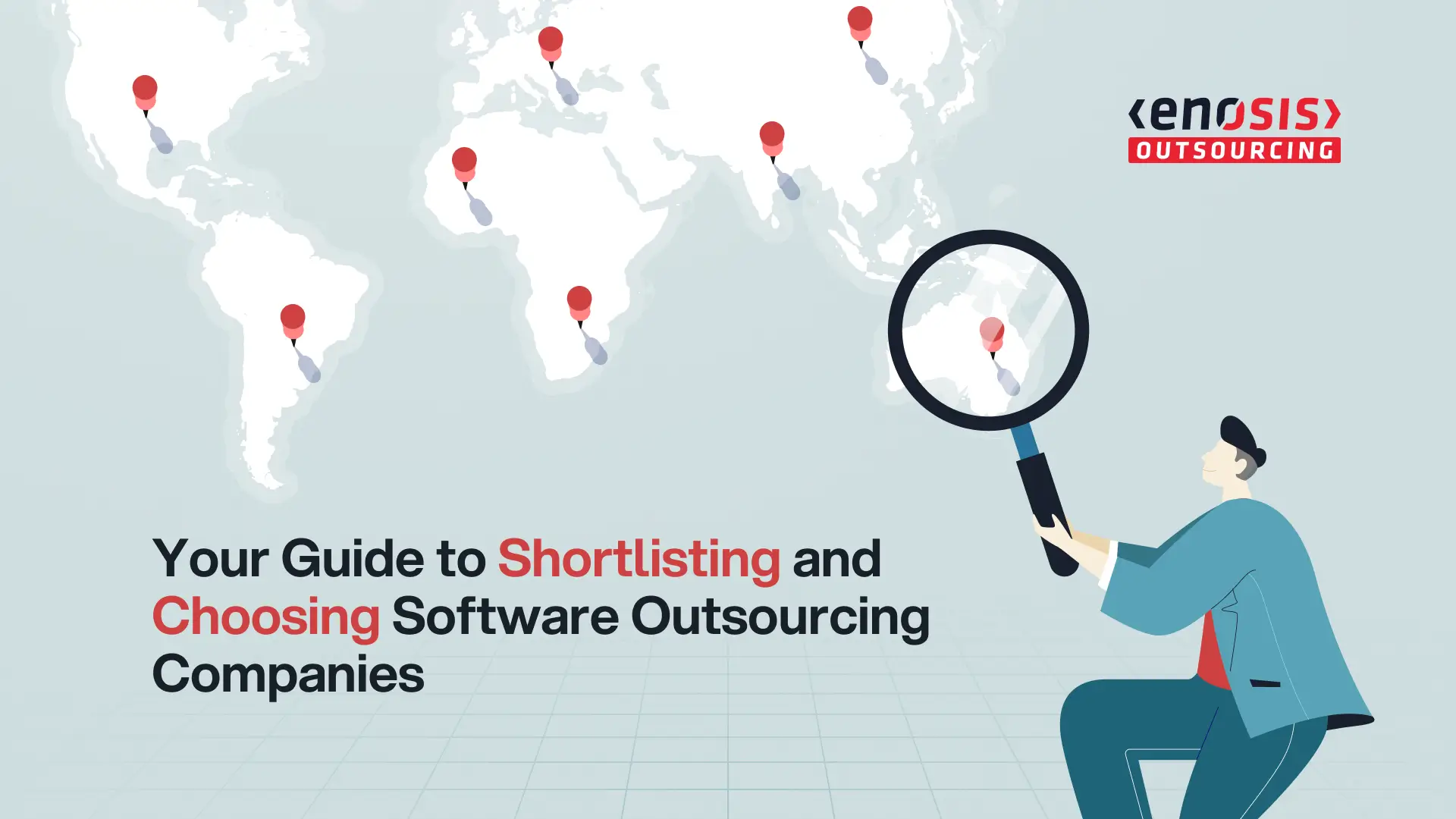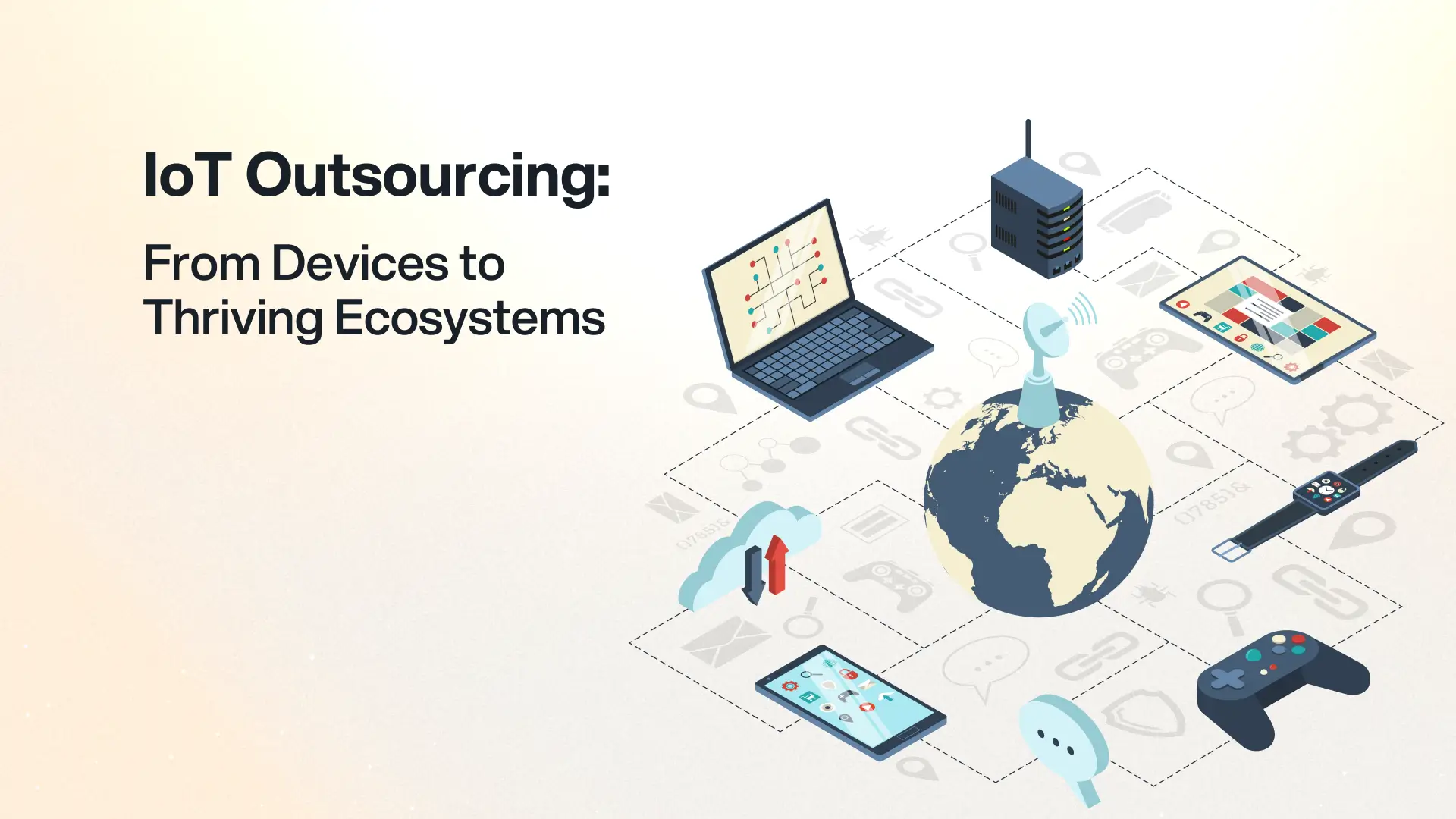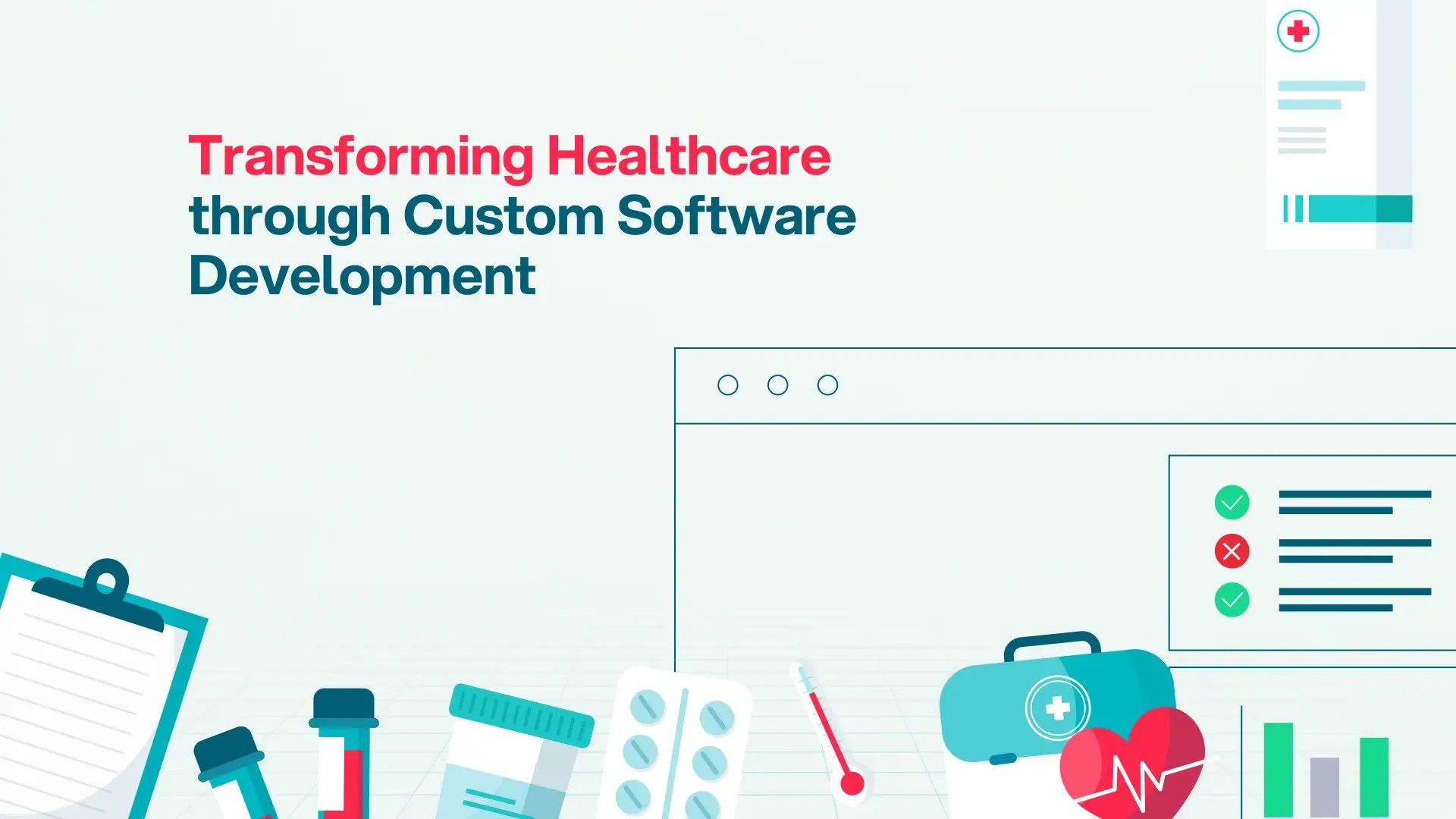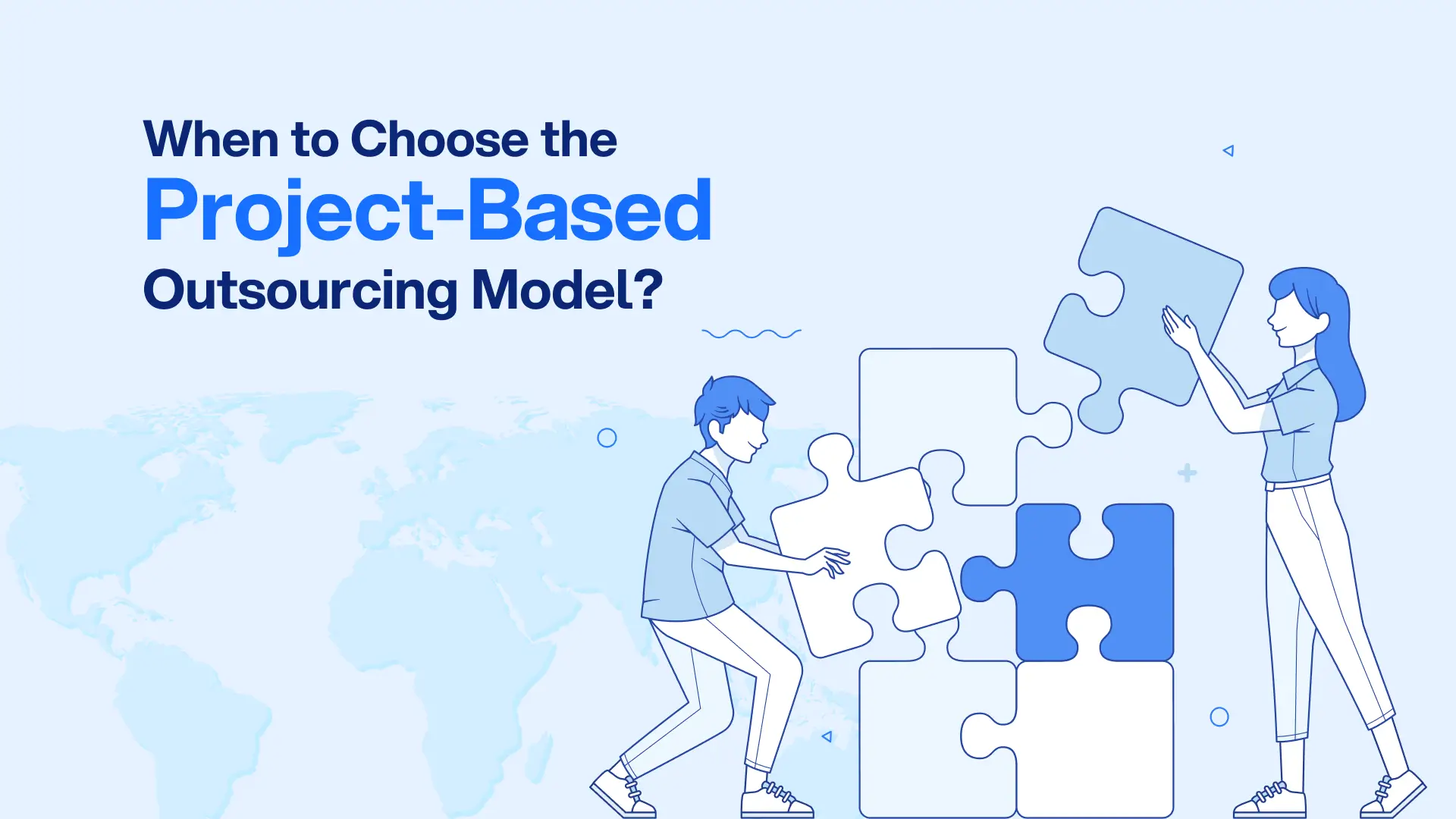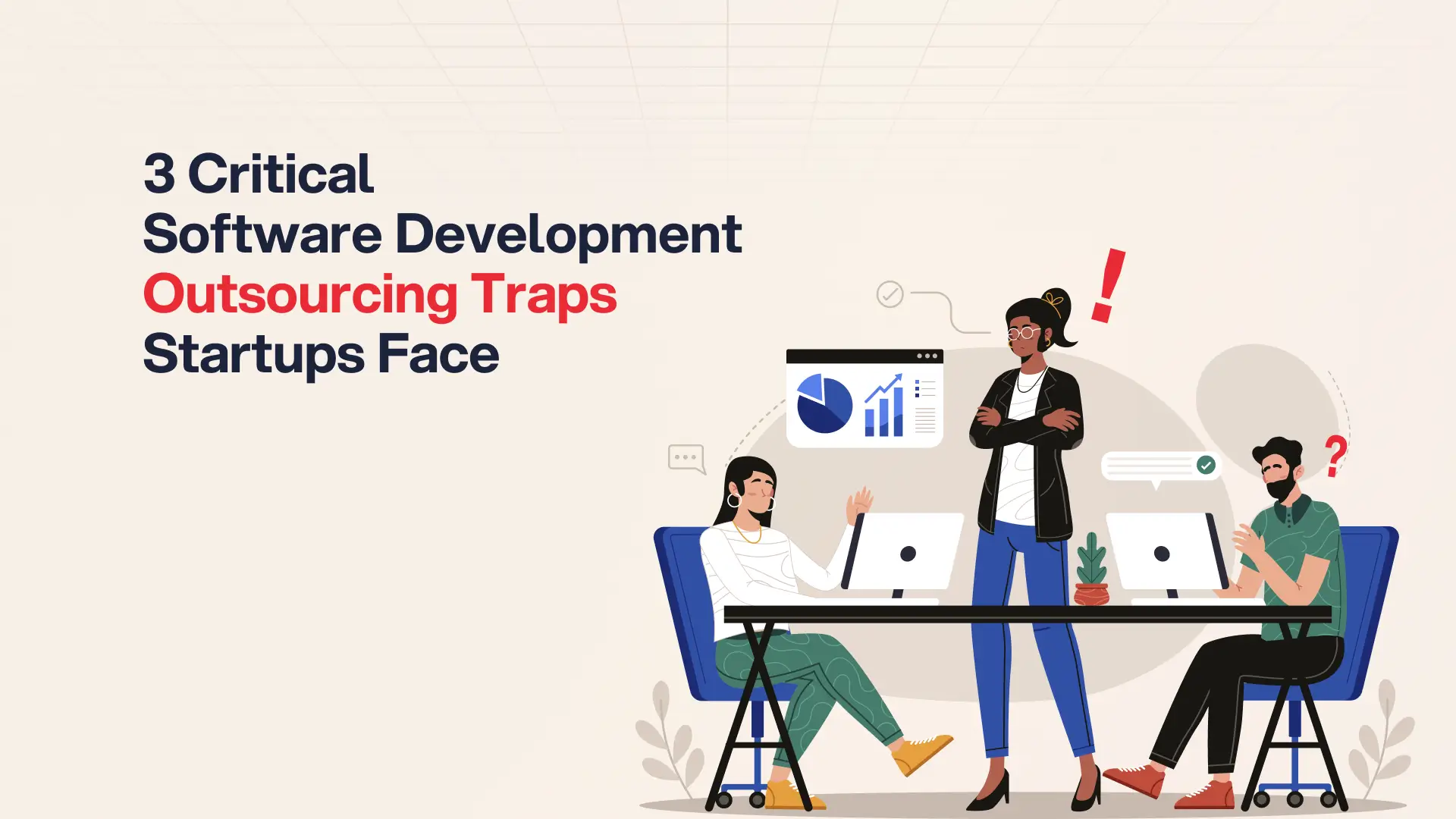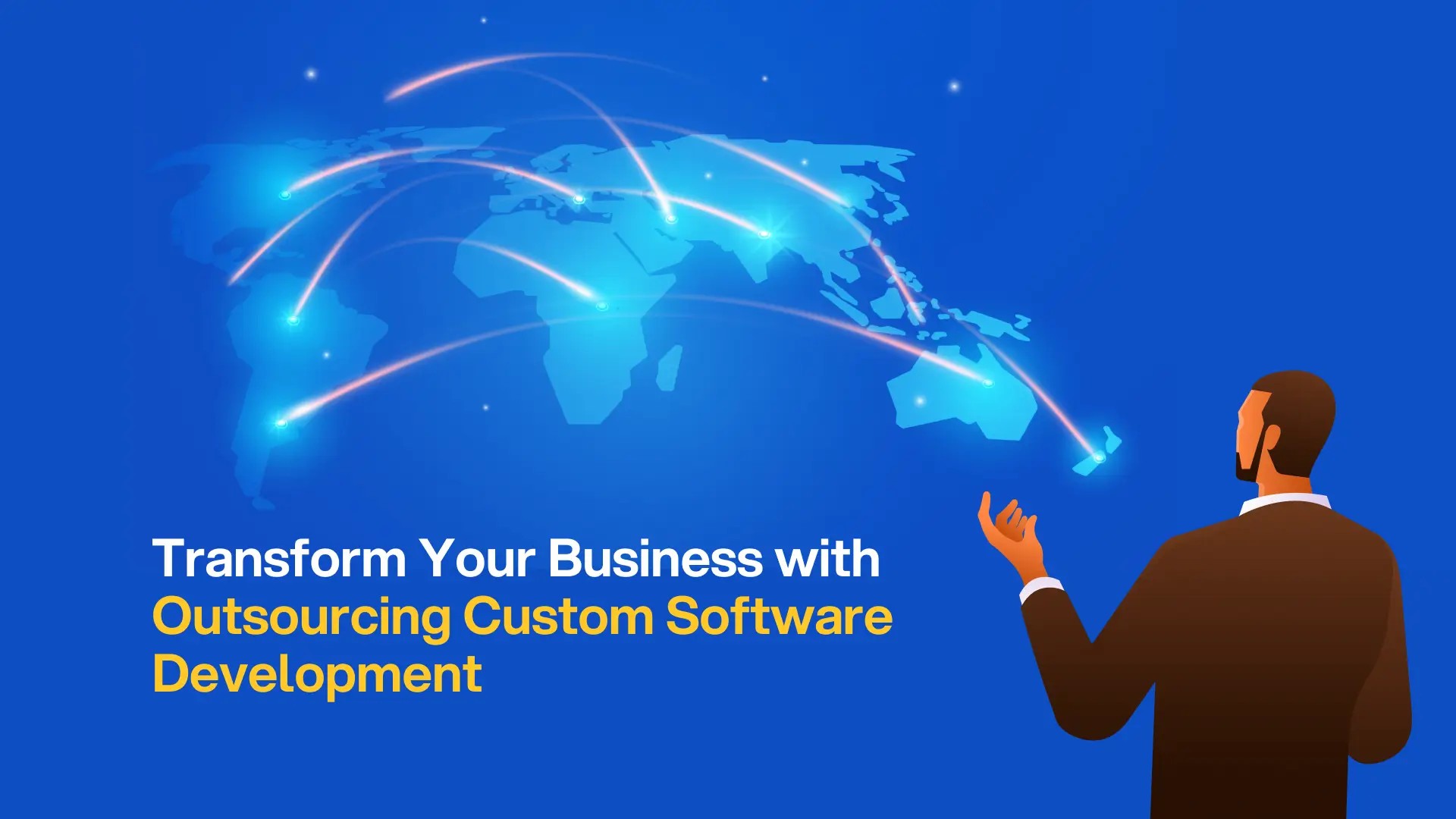Post Activity
 371
371
Table of Content
Share This Post
Table of Content
The global software outsourcing market is entering a new era. And it is defined by AI-driven innovation and outcome-based partnerships.
Choosing the right outsourcing partner can transform your business. It can help you accelerate productivity, bring in specialized expertise, and allow your internal teams to stay focused on high-value strategic work. But the wrong choice can just as easily derail a project and lead to budget overruns, security risks, and long-term technical debt.
Hundreds of vendors now offer overlapping services and traditional selection methods. Consequently, relying on cost comparisons or referrals is no longer enough. Modern buyers need a structured, evidence-based framework to evaluate partners on capability, compliance, and cultural fit. That’s what this guide is designed to provide.
In The 2025 Buyer’s Guide to Choosing Software Outsourcing Companies, you will find a practical roadmap for making informed, confident outsourcing decisions:
- The core functions and service lines of software outsourcing companies.
- When to outsource, and when to keep development in-house.
- The engagement and pricing models that align control, cost, and accountability.
- How geography, governance, and compliance shape delivery quality.
- The KPIs, SLAs, and RFP structures that keep partnerships transparent and measurable.
- How AI and automation are redefining vendor evaluation and delivery in the LLM era.
Whether you are selecting your first outsourcing partner or rethinking an existing relationship, this guide will help you move beyond gut-feel decisions toward data-backed, performance-driven partnerships.
What Software Outsourcing Companies Do
A software outsourcing company provides a contracted team of specialists for your software development needs. They design, develop, test, and operate your solutions as per your needs. Their level of involvement depends on your contract with them. The typical software development outsourcing service lines include:
- Product Engineering & Custom Development: The team designs and builds new applications and features that match your requirements. They are involved in the whole process from discovery to production.
- Cloud & DevOps: Specialists provision and manage cloud infrastructure, set up automated CI/CD, and apply SRE practices. These ensure that releases are frequent and reliable.
Thinking of Outsourcing?
Access a wide range of outsourcing companies and find your best fit.
- QA & Test Automation: The outsourcing partner defines a comprehensive QA plan. Then they implement automated and manual tests with clear coverage targets to prevent bugs from reaching users.
- Data, AI, and ML Engineering: The vendor team creates data pipelines, trains, and evaluates models. They can also integrate AI capabilities that improve user experience and operational efficiency.
- Modernization & Re-platforming: An outsourcing team will help you migrate your legacy systems to a modern, cloud-native architecture. This supports easier scaling, stronger security, and simpler maintenance.
- Managed Services / 24×7 Application Support: Provide round-the-clock support to ensure your products and solutions are up and running at all times.
You are expecting architecture specifications, source code, automated test suites, build and release pipelines, and a user manual. These deliverables are covered by written Service Level Agreements (SLAs) that also define uptime, security, and incident resolution.
Why Outsource in 2025
Outsourcing is best used to add capabilities, extend coverage, and work on non-core tech efforts that add long-term value. Here are the most common drivers and critical-path reasons to keep development in-house.
Strong Reasons to Outsource
- Speed and Capacity: Quickly onboard skills you don’t currently have. Such as mobile, data science, or platform engineering, without the lengthy hiring process.
- Focus on Core Business: Allow your core team to concentrate on product strategy and innovation. Let a trusted partner handle the day-to-day build and operational tasks.
- Global Coverage & Speed: Use teams in multiple time zones to support follow-the-sun workflows, increase release cadence, and improve QA throughput.
For deeper insight into how outsourcing became a driver of growth, explore our article on Strategic Benefits of Outsourcing.
When Not to Outsource
- Programs that require deep internal learning: If your objective is to build durable capability in a new technology or domain, lead with your own team. Use an external partner only as coaches or for short accelerators that transfer knowledge and practices.
- Cultural or process mismatch you cannot bridge: If time zones, language, or working style will block daily collaboration, and you cannot assign a strong internal lead to bridge the gap, keep that work in-house.
- Executive intent framed as a quick patch: If the primary goal is to meet an unrealistic date or to increase headcount quickly, outsourcing will add coordination overhead and new risks. Reframe the plan with an achievable scope, or keep the work inside until the conditions improve.
A simple decision rule: If your goals are speed, coverage, or access to scarce skills, start with a scoped engagement and measurable outcomes.
Outsourcing Trends You Should Know About
The IT landscape is constantly evolving. Analysts expect global IT spending to exceed $5.4 trillion in 2025 (Gartner), with software and data-center investments outpacing other segments. This is largely driven by new AI workloads.
- AI is Reshaping the Industry: Demand for cloud and Anything-as-a-Service (XaaS) remains strong. Some regions show caution in managed services. Nonetheless, the outsourcing market sees a mix of large deals and a rebound in smaller, more agile projects.
- Validate AI claims: “Agentic AI” is currently a major buzzword. Buyers must be diligent in verifying a vendor’s true AI capabilities versus “agent-washing.”
What this means for you: Prioritize partners who can demonstrate tangible AI delivery experience, including secure, prompt engineering, robust evaluation frameworks, and transparent cost controls. They should be able to show measurable productivity gains, such as reduced cycle times or lower defect escape rates.
Engagement-Based Outsourcing Models
Outsourcing relationships usually fall into three patterns based on how the vendor works with your team. Sometimes you need extra hands that plug into your process. Other times, you need a partner to deliver a defined outcome from a scoped brief with a clean handover. The right choice depends on how much control you want to keep and how stable your scope is.
- Staff Augmentation: The company manages the project and developers directly. The vendor supplies the talent. This model is best for filling short-term skill gaps but comes with the risk of high coordination overhead.
- Dedicated (Managed) Team: The vendor manages the day-to-day of the project and team ceremonies. But the governance is shared by both the vendor and the client company. This is ideal for long-term projects.
- Project-Based / Fixed Scope: The project has a clearly defined Statement of Work (SOW), fixed milestones, and strict acceptance criteria. This works best for well-understood builds where the scope is unlikely to change, like MVPs.
Ready to Build Your Team?
Let’s create together, innovate together, and achieve excellence together. Your vision, our team – the perfect match awaits.
Pricing-Based Outsourcing Models
Pricing structures define your payment structure with your outsourcing partner. The right model depends on how clearly your scope is defined and how much adaptability you need as the project evolves.
- Time & Materials (T&M): Offers the most flexibility for evolving scope. The company pays for the hours worked. To prevent budget overrun, implement safeguards like sprint budget caps and use earned-value tracking to monitor progress against spending.
- Fixed Price: Provides cost predictability for projects with a tightly defined scope. This model requires a change-control process and a crystal-clear “definition of done” to avoid disputes.
- Milestone-Based / Hybrid: Payments are linked to specific, measurable outcomes rather than hours worked. For example, a milestone might be reached when an API successfully passes 95% of its contract tests or when a new authentication feature is deployed to production and verified as stable.
Pro Tip: No matter the model, build exit ramps at milestone boundaries. Ensure your contract includes provisions for code and asset escrow to protect you if the relationship ends unexpectedly.
Where to Outsource (Geo Guide)
Location matters in outsourcing. The region you choose affects time zone overlap, communication quality, cost structure, and the depth of technical expertise available. Each geography brings unique strengths and trade-offs. Understanding these regional advantages helps you choose a destination that matches your project’s needs, budget, and delivery goals.
Americas
Countries like Mexico, Colombia, and Brazil provide strong overlap with North American working hours. This usually means improved collaboration and speedy feedback. These markets are gaining traction for agile product development, DevOps, and near-real-time support operations.
Europe
Poland, Romania, and Portugal stand out for advanced product engineering and deep expertise in data, AI, and machine learning. These teams operate within Western business cultures and regulatory frameworks. This makes collaboration smoother for Western companies seeking high technical quality and predictable delivery.
Asia
India, Vietnam, Bangladesh, and the Philippines remain leaders in global IT outsourcing thanks to their large, diverse talent pools. These regions excel in QA, cloud infrastructure management, and scalable software development. Many vendors in Asia have mature delivery models, strong English communication, and proven experience managing complex, enterprise-grade projects.
A closer look at Bangladesh
Bangladesh stands out as an emerging technology hub within Asia’s IT outsourcing market. The companies here largely offer software development, QA, and data engineering services. The government continues to invest heavily in digital infrastructure, talent development, and export incentives. This has created a strong foundation for sustainable growth. Bangladesh is quickly becoming a competitive alternative for companies seeking skilled talent, cost efficiency, and long-term delivery partnerships in South Asia.
Africa
Countries such as Egypt and Kenya are quickly establishing themselves as emerging outsourcing hubs. They offer favorable time zones for serving the EMEA region, competitive pricing, and a growing number of skilled engineers. Africa’s tech ecosystem is becoming an attractive option for long-term diversification. Especially due to the increasing investment in digital infrastructure and education.
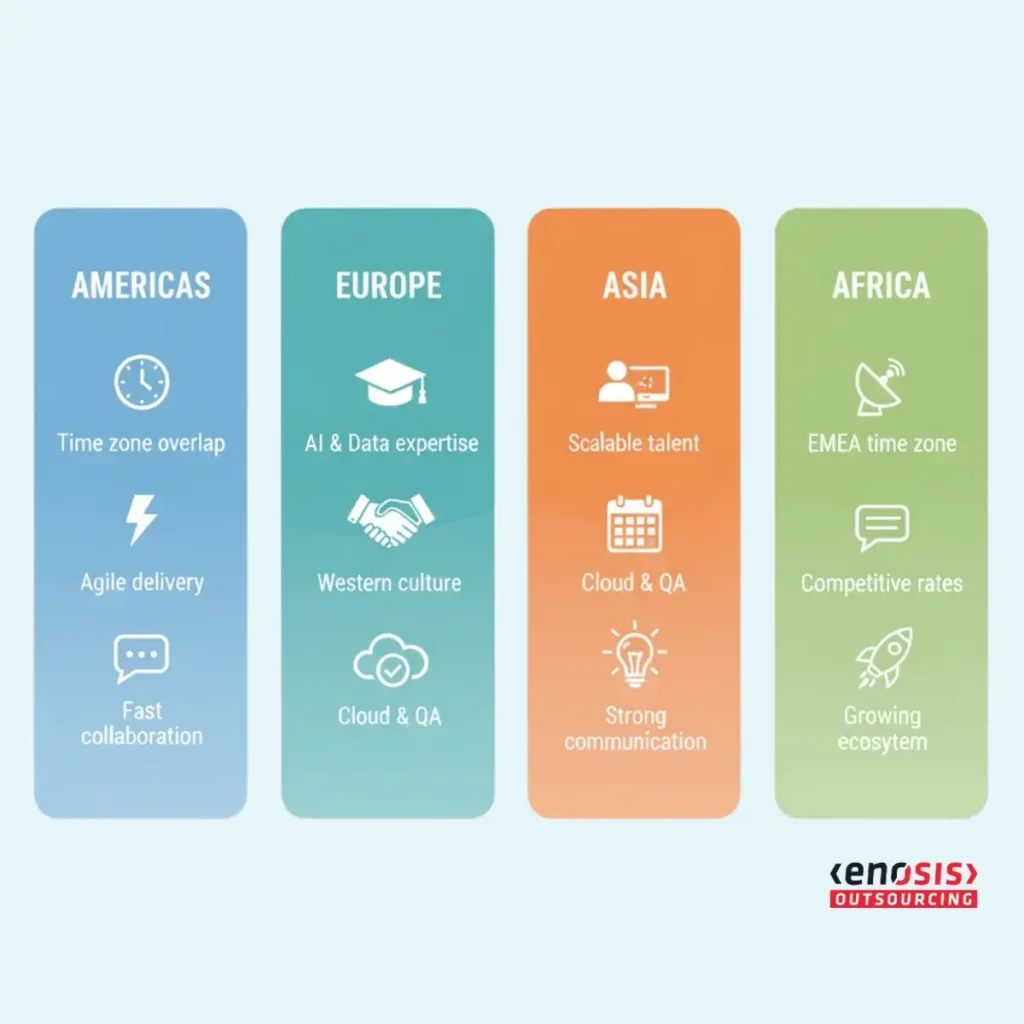
Security and Compliance
Protecting data, intellectual property (IP), and regulatory compliance are critical aspects of an outsourcing partnership. A strong compliance foundation only reduces legal and operational risk and builds long-term trust between the parties. To strengthen this foundation, explore ‘Cybersecurity Best Practices in Outsourcing Partnership‘, which outlines how to safeguard sensitive data, prevent breaches, and maintain trust in vendor relationships.
Data Processing Agreements (DPAs)
If your vendor processes personal or customer data, a DPA is mandatory. It must comply with global regulations such as GDPR Article 28. It should outline how data is collected, stored, accessed, and shared. The agreement should also define responsibilities, provide transparency, and include documented security obligations.
What to ask from potential vendors
- Certifications: Look for verifiable standards such as SOC 2 Type II or ISO/IEC 27001, which demonstrate mature information security management practices.
- Security evidence: Request proof of secure Software Development Life Cycle (SDLC) practices, including threat modeling, static and dynamic application security testing (SAST/DAST).
- Intellectual property and data policies: Ensure there are clear IP assignment clauses, defined open-source software governance, and options for data residency within required jurisdictions.
- A GDPR-ready DPA: The agreement should include a complete list of approved sub-processors, data retention timelines, and procedures for incident reporting and breach notifications.
A well-structured security and compliance framework is a legal necessity. Furthermore, it is the foundation for operational reliability, risk management, and business continuity in any outsourcing relationship.
Essentials for Strong Governance
Strong governance turns an outsourcing endeavor into a functioning partnership. It defines how teams make decisions and stay accountable. A well-structured governance framework builds transparency and ensures that both sides measure success the same way.
30/60/90 Day Plan
The 30/60/90-day plan is a standard governance tool in outsourcing. It creates structure and measurable momentum from the start of a partnership.
- First 30 days: Focus on setup and alignment. Complete onboarding, grant environment access, share documentation, and agree on architecture and delivery cadence.
- Next 60 days: Shift to execution. Deliver initial features or proofs of value, establish CI/CD pipelines, and stabilize collaboration routines.
- Final 90 days: Optimize workflows and governance. Track KPIs and finalize long-term cadence.
By the end of 90 days, the engagement should be fully operational. It should have clear ownership, transparent communication, and consistent performance against defined success metrics. This framework ensures both client and vendor build trust, accountability, and a strong foundation for scalable delivery.
RACI Matrix
Use a Responsibility, Accountability, Consultation, and Information (RACI) matrix to clarify ownership. It should define who leads, approves, advises, and stays informed across areas such as architecture, backlog management, QA, release cycles, and incident response. Clear accountability prevents duplication, gaps, and delays.
Communication Cadence
Establish a predictable rhythm for collaboration. Daily stand-ups to maintain operational flow; weekly demos for progress visibility; monthly steering committee meeting to align priorities; and quarterly business reviews to evaluate long-term goals and performance metrics.
Shared Risk Register
Maintain a living document that tracks all dependencies, schedule risks, security exposures, and vendor-related concerns. Each item should have an assigned owner, mitigation plan, and review frequency. This shared register ensures both teams manage risks proactively rather than reacting to surprises.
When executed well, this governance structure gives you continuous visibility into progress, accountability across teams, and confidence that your outsourcing partner is delivering to plan.
Find Your Perfect Software Outsourcing Partner
Unlock a world of trusted software outsourcing companies and elevate your business operations seamlessly.
A practical 15-point vendor checklist
Selecting the right outsourcing partner requires evaluating vendors objectively across delivery quality, governance, and risk control. The following checklist helps companies get a primary idea of what line of questions should be addressed.
- Domain fit: Do they have case studies and references relevant to your industry?
- Technical quality: Can they share anonymized architecture diagrams, code samples, or test reports?
- Team composition: What is the mix of senior, mid-level, and junior engineers?
- Delivery metrics: Do they track lead time, change failure rate, and mean time to resolution?
- Security posture: Are they SOC 2 or ISO 27001 certified? How fast do they fix vulnerabilities?
- Data protection: Do they provide a GDPR-ready DPA and list all sub-processors?
- Tooling and automation: How mature are their DevOps, CI/CD, and Infrastructure-as-Code practices?
- Testing strategy: What level of test coverage is standard, and how much is automated?
- Communication: What is the time-zone overlap, language proficiency, and escalation path?
- Financial health: Are they stable, insured, and reference-verified?
- Hiring and retention: What are their attrition rate, bench depth, and backfill SLAs?
- Knowledge management: How do they document work—runbooks, wikis, or ADRs?
- IP and licensing: Is IP ownership clear, and do they manage open-source use responsibly?
- Pilot plan: Are they open to a 4 to 6-week paid pilot with defined success metrics?
- Exit plan: Do they document handover, knowledge transfer, and access revocation steps?
KPIs and SLAs to Consider
Measuring the right metrics is critical to keeping an outsourcing partnership accountable and aligned with business goals. The focus should be on outcomes that create value, not just activity levels or effort spent. Effective KPIs and SLAs translate engineering progress into tangible business results, helping both client and vendor manage performance objectively.
Execution Pace
Track how efficiently tasks move through the pipeline. Key indicators include lead time for changes and throughput. These are measured by features delivered per sprint. These metrics show whether delivery speed and predictability are improving over time.
Quality
Monitor escaped defects, test coverage, and defect aging to ensure that speed does not come at the expense of reliability. Strong automation and early testing should lower post-release issues and support stable delivery.
Reliability
Measure system performance through uptime and availability (SLOs), mean time to resolution (MTTR), and change failure rate. These metrics indicate operational stability and responsiveness.
Value
Track outcomes that reflect business impact, such as feature adoption rate, cycle time to business outcome, and cost per story point over time. These help assess whether delivery efforts are driving measurable ROI.
Security
Include indicators like time to patch critical vulnerabilities and Software Bill of Materials (SBOM) freshness to verify that the vendor maintains strong, up-to-date security practices.
Together, these KPIs and SLAs ensure that progress is transparent, measurable, and directly tied to business performance rather than superficial activity metrics.
RFP Outline You Can Use
A clear and structured Request for Proposal (RFP) helps you compare vendors fairly and set the tone for a transparent partnership. It defines expectations early and reduces the back-and-forth all shortlisted companies respond to the same criteria. Below is a practical outline you can adapt for your next outsourcing engagement.
Context and Business Outcomes
Describe your organization’s goals, desired outcomes, and key non-functional requirements such as performance, scalability, or security.
Current Architecture
Provide an overview of your existing systems, technology stack, integrations, and known constraints. This helps vendors propose realistic solutions.
Scope of Deliverables
Define what you expect to receive inducing source code, documentation, tests, deployment pipelines, and handover assets.
Backlog Shape
Include sample epics or features with acceptance criteria to give vendors a sense of complexity and workflow.
Compliance Requirements
List required standards such as GDPR/DPA, SOC 2, or ISO 27001 to ensure data protection and regulatory alignment.
Proposed Team Model
Specify expected roles, team size, location mix, and required overlap hours for communication and collaboration.
Required KPIs and SLAs
Reference the key performance indicators and service levels outlined earlier. This should cover delivery speed, quality, reliability, and security.
Pilot Scope
Define a short 4 to 6 week pilot project with measurable success criteria and decision gates before scaling further.
Pricing Template
Request comparable quotes using time and materials, fixed-scope, or milestone-based pricing models.
Exit Plan Requirements
Outline what must be returned at the end of the engagement. This comprises source code, documentation, credentials, data, and a clear access revocation process.
A well-structured RFP like this helps you shortlist vendors on capability, transparency, and cultural fit, leading to smoother onboarding and better long-term delivery outcomes.
Start Your Outsourcing Journey Today!
Access a Curated Network of Top Software Development Companies and Find your Best Fit.
LLM-Era Delivery Best Practices
The rise of genAI is reshaping how outsourced teams deliver software. AI tools can significantly improve productivity, testing accuracy, and documentation quality. However, they also introduce new risks around data security, model governance, and cost transparency. To get real value from AI, clients should expect vendors to follow structured AI Optimization (AIO) and Large Language Model Optimization (LLMO) practices.
To see how emerging technologies like AI and IoT are reshaping outsourced delivery, read The CTO’s Guide to Outsourcing IoT Development.
AI Optimization (AIO)
Vendors should treat AI as a measurable engineering asset, not a black box. Require them to:
- Instrument all AI-assisted coding and QA activity.
- Maintain prompt libraries for consistency and reuse.
- Run evaluation tests for code correctness and stability.
- Provide dashboards that track AI latency, accuracy, and usage costs.
Large Language Model Optimization (LLMO)
For AI tools to perform reliably, vendor knowledge must be organized and auditable. Ensure your partner:
- Maintains atomic documentation (FAQs, runbooks, ADRs) for precise retrieval.
- Tracks prompt and model versions in Git to preserve traceability.
- Enforces PII redaction and secure data handling policies.
- Uses Software Bills of Materials (SBOMs) to verify the origin and safety of AI-generated code.
By holding vendors accountable to these practices, you ensure that AI adoption enhances your software quality, compliance posture, and delivery efficiency.
Why Use a Curated Marketplace
Researching dozens of vendors, verifying credentials, and comparing proposals often takes weeks. A curated marketplace simplifies that process by bringing pre-vetted providers into one platform.
Instead of starting from scratch, you can filter companies by service type, location, rate, and industry expertise. This instantly narrows your options to those that fit your project profile. Most marketplaces also include verified reviews, portfolio samples, compliance certifications, and performance data. This gives you a good understanding of the companies before you even schedule a call.
This saves time, reduces due diligence costs, and minimizes selection risk. It also helps you focus your evaluation on the most relevant and reliable partners.
Final Thoughts
Software outsourcing in 2025 has evolved into a strategic partnership model. It can unlock scale, innovation, and long-term competitiveness if implemented properly. As technology continues to accelerate and new business models emerge, outsourcing has become a way for organizations to extend capabilities.
The insights shared in this guide are designed to help business leaders build outsourcing partnerships that deliver measurable value, reduce risk, and align tightly with long-term goals. Let’s revisit the key takeaways that shape a successful outsourcing strategy in 2025 and beyond.
Bonus: One-Page Vendor Scorecard
Selecting a software outsourcing partner involves more than comparing quotes or portfolios. To make the process objective and repeatable, use a standardized vendor scorecard like the one below. It helps you measure each provider’s technical capability, governance maturity, and overall fit using consistent, evidence-based criteria.
Each criterion in the scorecard represents a core aspect of vendor performance. This ranges from domain expertise to communication effectiveness. Every factor has an assigned weight to indicate its importance, adding up to a total of 70 points. You then assign each vendor a score from 0 to 2 based on how well they meet expectations:
- 0 – Below standard or insufficient evidence
- 1 – Meets baseline expectations
- 2 – Exceeds expectations or demonstrates proven excellence
Multiply each score by its weight to calculate the weighted total. A vendor with a total score of 24 or higher qualifies as a strong candidate for your shortlist. Scores between 20 and 23 warrant a pilot project to validate capabilities, while scores below 20 typically indicate insufficient fit or maturity.
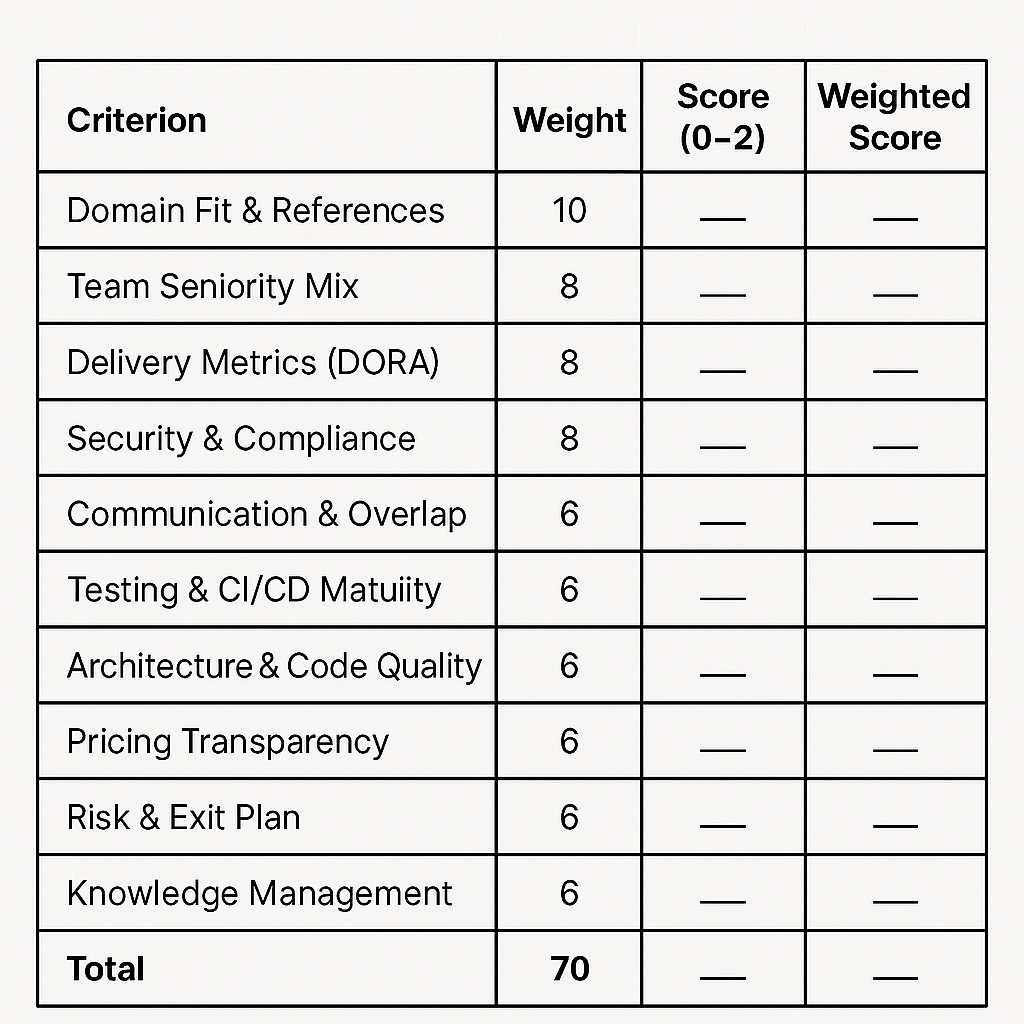
This scorecard ensures that vendor selection is not based on intuition or marketing claims, but on verifiable performance indicators. It creates transparency, reduces bias, and provides a clear audit trail for leadership decisions. This helps businesses shortlist partners who can consistently deliver secure, high-quality, and business-aligned outcomes.
Frequently Asked Questions (FAQs)
Which country is best for software outsourcing in 2025?
There’s no single “best” country. The right choice depends on your specific needs. Match your requirements to a region’s strengths: Latin America for U.S. time-zone overlap, Eastern Europe for deep product engineering expertise, and South/Southeast Asia (including Bangladesh) for scale in QA and data engineering.
How do I minimize outsourcing risks?
Start with a time-boxed pilot project to test the relationship. Require full visibility into their code repositories, define clear KPIs and SLAs from the start, and maintain a documented exit plan that includes asset escrow.
What’s the difference between staff augmentation and a dedicated team?
In a staff augmentation model, you manage the individuals directly. With a dedicated team, the vendor manages the day-to-day delivery and is accountable for shared outcomes and governance.
How do I protect my intellectual property?
Use a contract with strong IP assignment clauses, insist on a GDPR-compliant DPA that provides transparency on all sub-processors, and enforce role-based access control for all code repositories and sensitive data.
What should I expect to see in the first 30–60 days?
Within the first 30 days, all team members should have the access they need. Within 4–6 weeks, you should see a working CI/CD pipeline and a demonstrable “thin slice” of the application, along with dashboards tracking the agreed-upon KPIs.
Find Your Perfect Software Outsourcing Partner
Unlock a world of trusted software outsourcing companies and elevate your business operations seamlessly.

